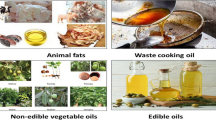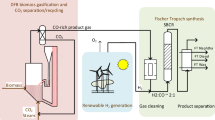Abstract
The search for renewable fuels or components which may improve or replace fossil fuels is an important step towards a sustainable future. In particular, the pine oleoresin produced by conifer trees, which is composed by turpentine oil and non-volatile rosin, may be transformed into alternative fuels. In this work, combustion of six molecules which can be obtained from oleoresin either by distillation (i.e., α- and β-pinene) or by further oxyfunctionalization (nopol, terpineol, myrtenol, and borneol) was studied to assess the potential of pine oleoresin as raw material for biofuels. Emission indices of the main pollutants (carbon monoxide—CO, unburned hydrocarbons—UHC, and nitrogen oxides—NOx) were obtained in non-premixed co-flow laminar flames of the oleoresin-derived molecules blended with n-heptane. The main characteristics of the flames (i.e., temperature and height) were also determined. Significant increase in flame temperature and reduction in CO and UHC emissions with respect to n-heptane were observed with nopol, terpineol, and myrtenol, along an increase in NOx emissions, suggesting an improvement in combustion performance. In addition, differences in emission indices, evidenced for these molecules (even between α- and β-pinene), suggest the importance of the molecular structure in the combustion reaction.










Similar content being viewed by others
References
Anand BP, Saravanan CG, Srinivasan CA (2010) Performance and exhaust emission of turpentine oil powered direct injection diesel engine. Renew Energy 35:1179–1184. https://doi.org/10.1016/j.renene.2009.09.010
Baukal CE (2013) The John Zink Hamworthy combustion handbook Volume 1, Fundamentals, 2nd ed. CRC Press/Taylor & Francis, Boca Raton
Becke AD (1992) Density-functional thermochemistry. II. The effect of the Perdew-Wang generalized-gradient correlation correction. J Chem Phys 97:9173–9177. https://doi.org/10.1063/1.463343
Bradley D, Matthews KJ (1968) Measurement of high gas temperatures with fine wire thermocouples. J Mech Eng Sci 10:299–305. https://doi.org/10.1243/jmes_jour_1968_010_048_02
Cao S, Ma B, Giassi D, Bennett BAV, Long MB, Smooke MD (2018) Effects of pressure and fuel dilution on coflow laminar methane–air diffusion flames: a computational and experimental study. Combust Theory Model 22:316–337. https://doi.org/10.1080/13647830.2017.1403051
Chelladorai P, Varuvel EG, Martin LJ, Nagalingam B (2019) The potential impact of unsaturation degree of the biodiesels obtained from beverage and food processing biomass streams on the performance, combustion and emission characteristics in a single-cylinder CI engine. Environ Sci Pollut Res 26:5008–5019. https://doi.org/10.1007/s11356-018-3793-1
Datta A, Hossain A, Roy S (2019) An overview on biofuels and their advantages and disadvantages. Asian J Chem 31:1851–1858. https://doi.org/10.14233/ajchem.2019.22098
Directive (EU) 2018/2001 of the European Parliament and of the COUNCIL of 11 December 2018 on the promotion of the use of energy from renewable sources
Eveleigh A, Ladommatos N, Balachandran R, Marca A (2014) Conversion of oxygenated and hydrocarbon molecules to particulate matter using stable isotopes as tracers. Combust Flame 161:2966–2974. https://doi.org/10.1016/j.combustflame.2014.05.008
Fridlyand A, Goldsborough SS, Brezinsky K (2013) Single pulse shock tube study on the effects of double bond position in unsaturated hydrocarbons and fatty acid methyl esters. In: Fall Technical Meeting of the Eastern States Section of the Combustion Institute 2013. Combustion Institute, pp 304–309
García D, Ramos Á, Rodríguez-Fernández J, Bustamante F, Alarcón E, Lapuerta M (2020) Impact of oxyfunctionalized turpentine on emissions from a Euro 6 diesel engine. Energy 201:117645. https://doi.org/10.1016/j.energy.2020.117645
Glaude PA, Fournet R, Bounaceur R, Molière M (2010) Adiabatic flame temperature from biofuels and fossil fuels and derived effect on NOx emissions. Fuel Process Technol 91:229–235. https://doi.org/10.1016/j.fuproc.2009.10.002
Godwin DJ, Geo VE, Thiyagarajan S, Martin MLJ, Maiyalagan T, Saravanan CG, Aloui F (2019) Effect of hydroxyl (OH) group position in alcohol on performance, emission and combustion characteristics of SI engine. Energy Convers Manag 189:195–201. https://doi.org/10.1016/j.enconman.2019.03.063
Gupta VK, Kumar G, Kandpal J, Agrawal VK (2006) Diesel fuel-turpentine oil blends as substitute fuels for compression ignition engines. IN Patent N°. 2004DE01925
Harrington JA, Shishu RC (1973) A single-cylinder engine study of the effects of fuel type, fuel stoichiometry, and hydrogen-to-carbon ratio on CO, NO, and HC exhaust emissions. SAE Tech Pap 730476. https://doi.org/10.4271/730476
Hellier P, Talibi M, Eveleigh A, Ladommatos N (2018) An overview of the effects of fuel molecular structure on the combustion and emissions characteristics of compression ignition engines. Proc Inst Mech Eng Part D J Automob Eng 232:90–105. https://doi.org/10.1177/0954407016687453
Höfer R (2015) The pine biorefinery platform chemicals value chain. In: Pandey A, Höfer R, Taherzadeh M et al (eds) Industrial biorefineries & white biotechnology, 1st edn. Elsevier, Amsterdam
Kaiser EW, Siegl WO, Henig YI, Anderson RW, Trinker FH (1991) Effect of fuel structure on emissions from a spark-ignited engine. Environ Sci Technol 25:2005–2012. https://doi.org/10.1021/es00024a004
Karthikeyan R, Mahalakshmi N V. (2008) Turpentine blend composition with diesel oil. IN Patent N°. 211874
Kumar C, Rana KB, Tripathi B, Nayyar A (2018) Properties and effects of organic additives on performance and emission characteristics of diesel engine: a comprehensive review. Environ Sci Pollut Res 25:22475–22498
Kumar N, Sonthalia A, Pali HS, Sidharth (2020) Next-generation biofuels—opportunities and challenges. In: Gupta A., De A., Aggarwal S., Kushari A. RA (ed) Innovations in sustainable energy and cleaner environment. Springer Verlag, Singapoore, pp 171–191
Lapuerta M, Hernández JJ, Armas O (2000) Kinetic modelling of gaseous emissions in a diesel engine. In: SAE technical paper 2000-01-2939. SAE International
Lemaire R, Menanteau S (2017) Assessment of radiation correction methods for bare bead thermocouples in a combustion environment. Int J Therm Sci 122:186–200. https://doi.org/10.1016/j.ijthermalsci.2017.08.014
Lescura CR (2009) Additive for internal combustion engines. BR Patent N°. 2007002126
Liang S (2005) Biological diesel fuel and its production. CN Patent N°. 1563279
McAllister S, Chen J-Y, Fernandez-Pello AC (2011) Fundamentals of combustion processes. Springer US, New York
Mishra DP (2014) Experimental combustion: an introduction. CRC Press/Taylor & Francis, Boca Raton
Naber JD, Siebers DL (1996) Effects of gas density and vaporization on penetration and dispersion of diesel sprays. In: SAE technical papers 960034
Norton TS, Dryer FL (1991) The flow reactor oxidation of C1-C4 alcohols and MTBE. Symp Combust 23:179–185. https://doi.org/10.1016/S0082-0784(06)80257-2
Panithasan MS, Gopalakichenin D, Venkadesan G, Veeraraagavan S (2019) Impact of rice husk nanoparticle on the performance and emission aspects of a diesel engine running on blends of pine oil-diesel. Environ Sci Pollut Res 26:282–291. https://doi.org/10.1007/s11356-018-3601-y
Raghavan V (2016) Combustion technology: essentials of flames and burners. John Wiley & Sons Ltd., Chichester
Roper FG, Smith C, Cunningham AC (1977) The prediction of laminar jet diffusion flame sizes: part II. Experimental verification. Combust Flame 29:227–234. https://doi.org/10.1016/0010-2180(77)90113-4
Shaddix CR (1999) Correcting thermocouple measurements for radiation loss: a critical review. In: Jensen MK, Di Marzo M (eds) 33rd National Heat Transfer Conference NHTC’99, Albuquerque, USA
Turns S (2000) Pollutant emissions. In: Holamn JP, Lloyd J (eds) An introduction to combustion: concepts and applications, 2nd edn. McGraw-Hill, Singapore, pp 550–597
Vallinayagam R, Vedharaj S, Yang WM, Saravanan CG, Lee PS, Chua KJE, Chou SK (2014) Impact of ignition promoting additives on the characteristics of a diesel engine powered by pine oil–diesel blend. Fuel 117:278–285. https://doi.org/10.1016/j.fuel.2013.09.076
Veloo PS, Egolfopoulos FN (2011) Studies of n-propanol, iso-propanol, and propane flames. Combust Flame 158:501–510. https://doi.org/10.1016/j.combustflame.2010.10.001
Yaws CL (2014) Thermophysical properties of chemicals and hydrocarbons, 2nd edn. Elsevier, Amsterdam
Youchun LJC (2009) Preparation of environmentally-friendly liquid fuel with high heat value. CN Patent N°. 101531927
Zaman K (2017) Biofuel consumption, biodiversity, and the environmental Kuznets curve: trivariate analysis in a panel of biofuel consuming countries. Environ Sci Pollut Res 24:24602–24610. https://doi.org/10.1007/s11356-017-0087-y
Acknowledgments
The authors acknowledge Juan Miguel González from GCA-UdeA and Alexis Cova from GCM-UCLM for their support.
Nomenclature
DT thermocouple diameter, m
h convective heat transfer coefficient, W m−2 K−1
H height of flame tip, m
H0 height of flame tip for n-heptane, m
HAB height above burner, mm
k thermal conductivity, W m−1 K−1
MWFuel molecular weight of fuel, g mol−1
MWi molecular weight of species i, g mol−1
Nu Nusselt’s number
Pr Prandtl’s number
Q volumetric flow rate, m3 s−1
Re Reynold’s number
S molar stoichiometric oxidizer-to-fuel ratio
T0 Flame temperature for n-heptane, K
Tad adiabatic flame temperature, K
TF temperature of fuel stream, K
Tg temperature of gas stream, K
TTh temperature of the thermocouple joint, K
T∞ temperature of surroundings, K
V linear velocity of gas stream, m s−1
x number of carbon atoms in the fuel
xCO molar fraction of CO
xCO2 molar fraction of CO2
xi molar fraction of species i
XDil mole fraction of oxygen in the nitrogen stream
y number of hydrogen atoms in the fuel
z number of oxygen atoms in the fuel
α thermal diffusivity, m2 s−1
σ Stefan-Boltzmann constant, W m−2 K−4
ε emissivity of the thermocouple surface, W m−2 K−1
υ kinematic viscosity, m2 s−1
Funding
The authors received financial support from the Universidad de Antioquia and Ministerio de Ciencia, Tecnología e Innovación of Colombia (Minciencias) through projects PRG2014-1091 and 37-1-693 (ref. FP44842-124-2017), respectively. D.G. received doctoral scholarship 727/2015 from Minciencias.
Author information
Authors and Affiliations
Corresponding author
Additional information
Responsible Editor: Philippe Garrigues
Publisher’s note
Springer Nature remains neutral with regard to jurisdictional claims in published maps and institutional affiliations.
Electronic supplementary material
ESM 1
(DOCX 6932 kb)
Rights and permissions
About this article
Cite this article
García, D., Lapuerta, M., Villa, A.L. et al. Influence of molecular structure of oleoresin-derived compounds on flame properties and emissions from laminar flames. Environ Sci Pollut Res 27, 33890–33902 (2020). https://doi.org/10.1007/s11356-020-09555-w
Received:
Accepted:
Published:
Issue Date:
DOI: https://doi.org/10.1007/s11356-020-09555-w




